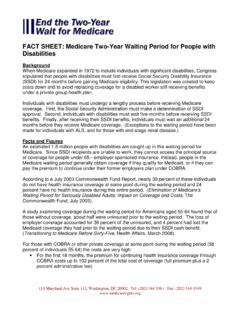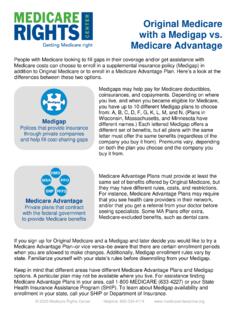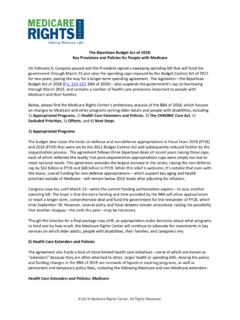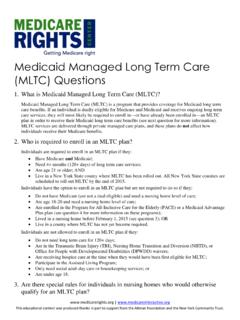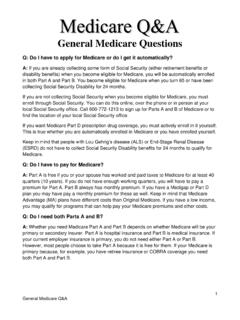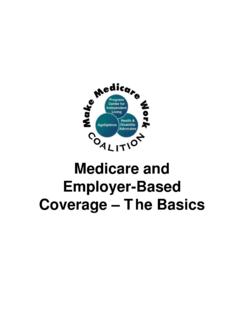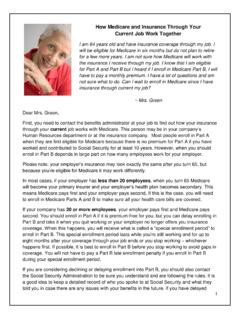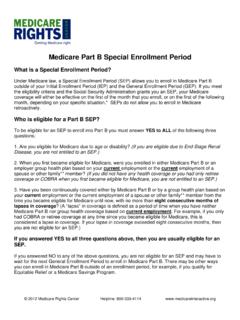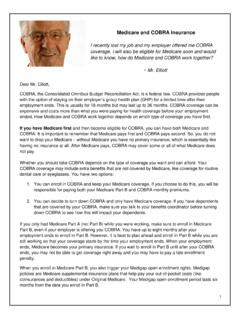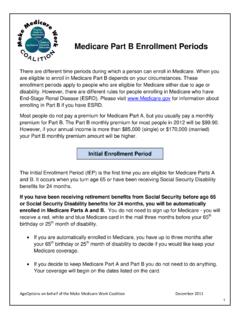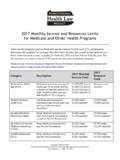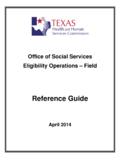Transcription of Medicare Part B Enrollment - Medicare Rights Center
1 Medicare part B Enrollment : Pitfalls, Problems and Penalties Recommendations to Improve the Medicare Enrollment System for Consumers November 2014 Prepared by: Stacy Sanders, Federal Policy Director Medicare Rights Center Acknowledgements Stacy Sanders, Federal Policy Director at the Medicare Rights Center , served as the primary author of this report. Rachel Bennett, Vice President of Program & Product Development, served as the primary editor. Special thanks are due to Joe Baker, Ilene Stein, Kim Glaun, Casey Schwarz, Josh Schultz, Samantha Morales and Mitchell Clark for research, writing, advisory, editing and design support. | Mr.
2 R: High Costs and Coverage Gaps Accompany Delayed Medicare Enrollment In 2001, at age 55, Mr. R retired from his job, and his former employer provided him with retiree medical coverage. Mr. R did not elect to begin collecting Social Security retirement benefits when he turned 65 and became eligible for Medicare . Individuals like Mr. R who are not collecting Social Security benefits must actively enroll in Medicare during their Initial Enrollment Period (IEP). During his IEP, Mr. R enrolled in Medicare part A (inpatient coverage), but declined part B (outpatient coverage), believing he would have adequate medical insurance under his retiree plan. What Mr. R did not know was that when he turned 65 and became eligible for Medicare , his retiree coverage became secondary to Medicare .
3 While current employer-sponsored health insurance can act as primary or secondary to Medicare , retiree insurance always pays secondary to Medicare , as determined by federal coordination of benefits rules. The Social Security Administration (SSA) called Mr. R while he was in the process of declining part B and asked him to confirm that he wanted to decline part B. According to Mr. R, he told Social Security, I have medical coverage; I don t need part B." At the same time, Mr. R s retiree health plan sent him two confusing notices in the months leading up to his 65th birthday. One notice warned that Mr. R could permanently lose his retiree benefits if he enrolled in other health coverage.
4 The other notice said that Mr. R s retiree benefits would be significantly reduced if he did not enroll in part B. The two notices appeared to contradict each other, and Mr. R did not act on the notice explaining the need to enroll in part B. When Mr. R became eligible for Medicare , his retiree plan stopped paying primary for outpatient services, essentially operating as though Mr. R had no insurance at all. During this time, Mr. R incurred at least $10,000 in medical expenses from two different health incidents. Only after these medical bills for unpaid expenses and denials from his retiree insurance started arriving did Mr. R realize that something was wrong. But Mr.
5 R was in a bind. Having missed his IEP, he had to wait for the General Enrollment Period (GEP) to enroll in part B. The GEP lasts from January through March of each year, with coverage beginning July 1st of the year a person enrolls. In the end, Mr. R enrolled in part B during the 2014 GEP more than a year after he first became eligible for part B with his coverage taking effect in July, seven months later. Reflecting on his experience, Mr. R said, If anybody says they don t want [ Medicare ] coverage, they should be asked more than once [whether by Social Security, their employer, or their former employer]. They should receive more [than one clear notice] letter and have to sign it, acknowledging that they don t want part B.
6 I went back to Social Security about six months ago, and a couple in front of me said they didn t want part B. It was all I could do to keep myself seated, instead of running up and explaining the consequences. 2 | Page Medicare part B Enrollment : Pitfalls, Problems and Penalties part B Enrollment Pitfalls Explained: Trends on the Medicare Rights Center Helpline An often-reported fact is that 10,000 Baby Boomers turn 65 and become Medicare -eligible each Less well known, and commonly misunderstood, are the rules concerning how to enroll in Medicare . While most newly eligible Medicare beneficiaries are automatically enrolled, others must make a proactive choice to enroll in one or multiple parts of the program, including part A, part B, part C and part D.
7 Through its direct service and educational programming, the Medicare Rights Center ( Medicare Rights ) regularly hears from older adults and people with disabilities who erred during this transition and struggle to cope with the consequences. At age 65, retirees already collecting Social Security retirement benefits are automatically enrolled in part A and part B. The same is true for individuals ages 64 and younger who are collecting Social Security disability benefits following a 24-month waiting period. For those not collecting Social Security benefits, it is necessary to actively enroll in Medicare , taking into consideration specific Enrollment periods and existing coverage.
8 If this transition is mismanaged, individuals new to Medicare may face lifetime late Enrollment penalties, higher health care costs, gaps in coverage and disruptions in care continuity. As evidenced by questions received on Medicare Rights national helpline, many struggle to understand Medicare Enrollment periods, coordination of benefits rules and the penalties associated with delayed Enrollment . In 2013, Medicare Rights fielded more than 15,000 questions on its national helpline, and the second most common call concerned Enrollment (22 percent). Nearly one-quarter of these calls were from individuals experiencing challenges enrolling in part B, whether because they were navigating a specific hurdle (38 percent), did not understand Enrollment periods (28 percent) or were unsure whether they were Medicare -eligible (13 percent).
9 While most newly eligible beneficiaries qualify for premium-free part A because they have sufficient work history, almost all beneficiaries pay a monthly part B This premium expense leads some to turn down part B when they first become eligible a choice that can have dire consequences. Another common issue for callers to Medicare Rights helpline and by extension for all Medicare beneficiaries involves understanding how Medicare coordinates with existing health Transitions to Medicare for those with retiree insurance, COBRA benefits and employer-sponsored coverage represent some of the most common transition points for newly eligible Medicare beneficiaries. Other transitions include the move to Medicare from traditional Medicaid, TRICARE and liability coverage.
10 Most recently, the Affordable Care Act (ACA) introduced two new transition points: those moving from Marketplace plans to Medicare and those moving from expansion Medicaid to In all cases, people new-to- Medicare must consider how their current health coverage will coordinate with Medicare benefits. While each specific transition presents its own unique challenges, Medicare Rights experience demonstrates that similar problems tend to apply across the board. Specifically, the most common pitfalls associated with delayed part B Enrollment can be broken into three categories: 3 | Page Medicare part B Enrollment : Pitfalls, Problems and Penalties 1. Navigating Coordination of Benefits Rules 2.
